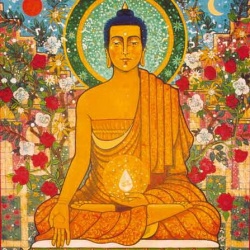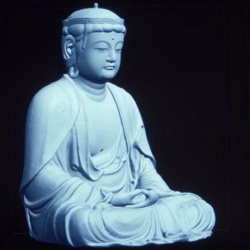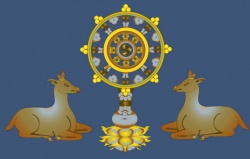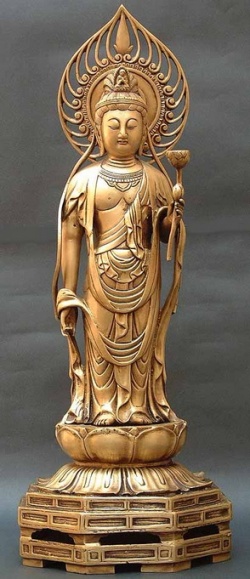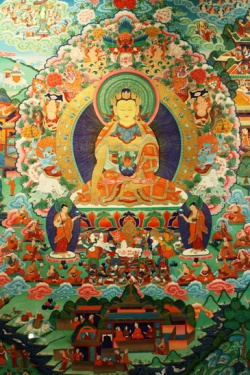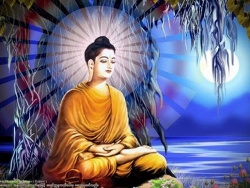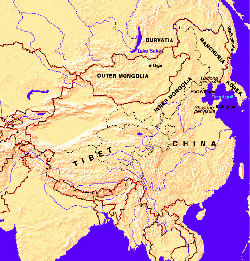Difference between revisions of "Exploitation of The Shambhala Legend for Control of Mongolia"
| (One intermediate revision by the same user not shown) | |||
| Line 1: | Line 1: | ||
| − | == The Division of Mongolia by Foreign Conquerors == | + | {{DisplayImages|355|1291|1452|1027|1578|597}} |
| − | The Manchus, Chinese, Russians, and Japanese have long competed for control of Northeast Asia, particularly of the Mongol regions. Since the days of Chinggis Khan and the Mongol Empire in the thirteenth and fourteenth centuries, all the nearby regional powers saw the Mongols as a potentially dangerous military force. It needed to be either neutralized by preventing Mongol unification or harnessed by promoting that unification. | + | == The Division of [[Mongolia]] by Foreign Conquerors == |
| + | The {{Wiki|Manchus}}, {{Wiki|Chinese}}, {{Wiki|Russians}}, and [[Japanese]] have long competed for control of {{Wiki|Northeast Asia}}, particularly of the Mongol regions. Since the days of {{Wiki|Chinggis Khan}} and the Mongol [[Empire]] in the thirteenth and fourteenth centuries, all the nearby regional [[powers]] saw the {{Wiki|Mongols}} as a potentially [[dangerous]] {{Wiki|military}} force. It needed to be either neutralized by preventing Mongol unification or harnessed by promoting that unification. | ||
| − | The Manchus created the division of Mongolia into Outer and Inner portions in 1636, when they captured Inner Mongolia and used it as a base for their conquest of China and establishment of the Qing Dynasty (1644-1911). After winning control of Outer Mongolia in 1691, the Manchus maintained the artificial division of Outer and Inner to prevent the Mongols from uniting against them. In 1729, Russia conquered and annexed Buryatia, the Mongol region north of Outer Mongolia, near Lake Baikal, further weakening Mongol unification. | + | The {{Wiki|Manchus}} created the division of [[Mongolia]] into Outer and Inner portions in 1636, when they captured {{Wiki|Inner Mongolia}} and used it as a base for their conquest of [[China]] and establishment of the {{Wiki|Qing Dynasty}} (1644-1911). After winning control of {{Wiki|Outer Mongolia}} in 1691, the {{Wiki|Manchus}} maintained the artificial division of Outer and Inner to prevent the {{Wiki|Mongols}} from uniting against them. In 1729, {{Wiki|Russia}} conquered and annexed [[Buryatia]], the Mongol region [[north]] of {{Wiki|Outer Mongolia}}, near {{Wiki|Lake Baikal}}, further weakening Mongol unification. |
| − | == The Start of Chinese-Russian-Japanese Rivalry in Northeast Asia == | + | == The Start of Chinese-Russian-Japanese Rivalry in {{Wiki|Northeast Asia}} == |
[[File:Asia_map1.gif|thumb|250px|]] | [[File:Asia_map1.gif|thumb|250px|]] | ||
| − | With the progressive decline of the Qing Dynasty in the second half of the nineteenth century, various powers sought to take advantage and expand their political and commercial empires. They included not only European nations such as Britain, France, Germany, and Portugal, but also Asian powers. Let us look at the struggle between Russia and Japan over Manchuria, Mongolia's neighbor to the east. Manchuria occupied a strategic position not only because of its ice-free ports on its southern coast along the Bohai Gulf, but also because it served the Qing emperors as a base for controlling Mongolia. The Japanese gained the Liaodong Peninsula of southern Manchuria, with Port Arthur (Dalian, Darien) at its tip, with their victory in the Sino-Japanese War of 1894-1895. In 1896, Czar Nicholas II forged an alliance with China against Japan and won the right to extend the Trans-Siberian railway through northern Manchuria to connect with the Russian Pacific port of Vladivostok. In so doing, Russia gained nominal control of northern Manchuria. Subsequently, through intense pressure from Russia and China, the Japanese withdrew from southern Manchuria. | + | With the progressive {{Wiki|decline}} of the {{Wiki|Qing Dynasty}} in the second half of the nineteenth century, various [[powers]] sought to take advantage and expand their {{Wiki|political}} and commercial empires. They included not only {{Wiki|European}} nations such as Britain, {{Wiki|France}}, {{Wiki|Germany}}, and {{Wiki|Portugal}}, but also {{Wiki|Asian}} [[powers]]. Let us look at the struggle between {{Wiki|Russia}} and [[Japan]] over [[Manchuria]], Mongolia's neighbor to the [[east]]. [[Manchuria]] occupied a strategic position not only because of its ice-free ports on its southern coast along the Bohai Gulf, but also because it served the Qing [[emperors]] as a base for controlling [[Mongolia]]. The [[Japanese]] gained the Liaodong Peninsula of southern [[Manchuria]], with {{Wiki|Port Arthur}} (Dalian, Darien) at its tip, with their victory in the Sino-Japanese [[War]] of 1894-1895. In 1896, {{Wiki|Czar}} [[Wikipedia:Nicholas II of Russia|Nicholas II]] forged an alliance with [[China]] against [[Japan]] and won the right to extend the Trans-Siberian railway through northern [[Manchuria]] to connect with the {{Wiki|Russian}} Pacific port of {{Wiki|Vladivostok}}. In so doing, {{Wiki|Russia}} gained nominal control of northern [[Manchuria]]. Subsequently, through intense pressure from {{Wiki|Russia}} and [[China]], the [[Japanese]] withdrew from southern [[Manchuria]]. |
| − | At the other side of the mouth of the Bohai Gulf, opposite Port Arthur, lay the Shandong Peninsula. After Germany seized its major port, Qingdao (Tsingtao), in 1897, Russia demanded further concessions from the Chinese Government. She was given control of Port Arthur and its Manchurian hinterland in 1898, and promptly connected it by rail to Vladivostok. Japan looked on uneasily, anxious to reestablish a power base on the Asian mainland. | + | At the other side of the {{Wiki|mouth}} of the Bohai Gulf, opposite {{Wiki|Port Arthur}}, lay the Shandong Peninsula. After {{Wiki|Germany}} seized its major port, Qingdao (Tsingtao), in 1897, {{Wiki|Russia}} demanded further concessions from the {{Wiki|Chinese}} Government. She was given control of {{Wiki|Port Arthur}} and its Manchurian hinterland in 1898, and promptly connected it by rail to {{Wiki|Vladivostok}}. [[Japan]] looked on uneasily, anxious to reestablish a power base on the {{Wiki|Asian}} mainland. |
| − | The Russo-Japanese War broke out over Manchuria in 1904. When the Japanese won in 1905, the Treaty of Portsmouth granted to them a long-term lease to Port Arthur, similar to what Britain had secured over Hong Kong and the New Territories with the Second Convention of Peking in 1898. The Japanese and Russians both agreed to restore Manchuria to Chinese control, but looked on for any opportunity to take it once more. In 1910, Japan seized and annexed Korea, which bordered the Liaodong Peninsula to the east. | + | The {{Wiki|Russo-Japanese War}} broke out over [[Manchuria]] in 1904. When the [[Japanese]] won in 1905, the Treaty of Portsmouth granted to them a long-term lease to {{Wiki|Port Arthur}}, similar to what Britain had secured over [[Hong Kong]] and the New Territories with the Second Convention of {{Wiki|Peking}} in 1898. The [[Japanese]] and {{Wiki|Russians}} both agreed to restore [[Manchuria]] to {{Wiki|Chinese}} control, but looked on for any opportunity to take it once more. In 1910, [[Japan]] seized and annexed [[Korea]], which bordered the Liaodong Peninsula to the [[east]]. |
| − | == The Start of Mongolian-Japanese Friendship == | + | == The Start of Mongolian-Japanese [[Friendship]] == |
| − | In 1911, on the eve of the Chinese Nationalist Revolution that overthrew the Qing Dynasty, the Eighth Jebtsundamba declared the independence of Outer Mongolia from China. The Jebtsundambas (Bogdo Khans) were the traditional Buddhist spiritual and political leaders of Mongolia, found through reincarnation in the same manner as the Dalai Lamas of Tibet. Pressure from Russia and China, however, forced the Jebtsundamba to accept autonomy under the new Chinese Nationalist Government in 1912, with Russian assistance to maintain that status. | + | In 1911, on the eve of the {{Wiki|Chinese}} Nationalist {{Wiki|Revolution}} that overthrew the {{Wiki|Qing Dynasty}}, the Eighth [[Jebtsundamba]] declared the {{Wiki|independence}} of {{Wiki|Outer Mongolia}} from [[China]]. The Jebtsundambas (Bogdo Khans) were the [[traditional]] [[Buddhist]] [[spiritual]] and {{Wiki|political}} leaders of [[Mongolia]], found through [[reincarnation]] in the same [[manner]] as the [[Dalai Lamas]] of [[Tibet]]. Pressure from {{Wiki|Russia}} and [[China]], however, forced the [[Jebtsundamba]] to accept autonomy under the new {{Wiki|Chinese}} Nationalist Government in 1912, with {{Wiki|Russian}} assistance to maintain that {{Wiki|status}}. |
| − | Taking advantage of the new situation in China, the Japanese soon extended its control of Port Arthur and Korea to southern Manchuria and eastern Inner Mongolia. In 1914, Russia allied with England against Germany and Turkey in the First World War. Preoccupied in Europe, Russia signed the Khiakta Treaty of 1914-1915 with China, reaffirming Chinese suzerainty over Outer Mongolia, and acquiesced to Japan's expansion on the Asian mainland. | + | Taking advantage of the new situation in [[China]], the [[Japanese]] soon extended its control of {{Wiki|Port Arthur}} and [[Korea]] to southern [[Manchuria]] and eastern {{Wiki|Inner Mongolia}}. In 1914, {{Wiki|Russia}} allied with England against {{Wiki|Germany}} and Turkey in the {{Wiki|First World War}}. Preoccupied in {{Wiki|Europe}}, {{Wiki|Russia}} signed the Khiakta Treaty of 1914-1915 with [[China]], reaffirming {{Wiki|Chinese}} suzerainty over {{Wiki|Outer Mongolia}}, and acquiesced to Japan's expansion on the {{Wiki|Asian}} mainland. |
| − | Meanwhile, Japan joined the war on the Allied side and seized the German holdings on the Shandong Peninsula. In the Twenty-one Demands signed between Japan and China in 1915, China acknowledged Japan's takeover of Shandong and recognized Japanese authority over southern Manchuria and eastern Inner Mongolia. | + | Meanwhile, [[Japan]] joined the [[war]] on the Allied side and seized the {{Wiki|German}} holdings on the Shandong Peninsula. In the Twenty-one Demands signed between [[Japan]] and [[China]] in 1915, [[China]] [[acknowledged]] Japan's takeover of Shandong and [[recognized]] [[Japanese]] authority over southern [[Manchuria]] and eastern {{Wiki|Inner Mongolia}}. |
| − | After the 1917 Russian Revolution, Lenin tore up the noninterference treaties concerning Mongolia that the Czar had previously signed with China. He hoped to spread Communism throughout Asia. The continuing world war and the outbreak of civil war in Russia, particularly in Siberia, prevented his immediate move. | + | After the 1917 {{Wiki|Russian Revolution}}, {{Wiki|Lenin}} tore up the noninterference treaties concerning [[Mongolia]] that the {{Wiki|Czar}} had previously signed with [[China]]. He hoped to spread {{Wiki|Communism}} throughout {{Wiki|Asia}}. The continuing [[world]] [[war]] and the outbreak of civil [[war]] in {{Wiki|Russia}}, particularly in {{Wiki|Siberia}}, prevented his immediate move. |
| − | The Jebtsundamba disliked both the Chinese and the Russians. He wished, instead, to establish a Greater Mongolia that would extend from Buryatia in Siberia to Inner Mongolia and northwestern Manchuria. Of the military powers in the region, the Jebtsundamba preferred Japan as the patron and protector of his envisioned state. Japan, after all, was a Buddhist country. The Japanese, in turn, were anxious to extend their sphere of influence in Northeast Asia to all of Mongolia. Thus, in 1918, the Japanese founded a Japanese-Mongol Buddhist Association and supported the plan for a Greater Mongolia. | + | The [[Jebtsundamba]] disliked both the {{Wiki|Chinese}} and the {{Wiki|Russians}}. He wished, instead, to establish a Greater [[Mongolia]] that would extend from [[Buryatia]] in {{Wiki|Siberia}} to {{Wiki|Inner Mongolia}} and northwestern [[Manchuria]]. Of the {{Wiki|military}} [[powers]] in the region, the [[Jebtsundamba]] preferred [[Japan]] as the {{Wiki|patron}} and [[protector]] of his envisioned state. [[Japan]], after all, was a [[Buddhist]] country. The [[Japanese]], in turn, were anxious to extend their [[sphere]] of influence in {{Wiki|Northeast Asia}} to all of [[Mongolia]]. Thus, in 1918, the [[Japanese]] founded a Japanese-Mongol [[Buddhist]] Association and supported the plan for a Greater [[Mongolia]]. |
| − | == The Establishment of Communism in Mongolia == | + | == The Establishment of {{Wiki|Communism}} in [[Mongolia]] == |
| − | At the end of 1919, several Mongol princes, under intense pressure from the Chinese and without the consent of the Jebtsundamba, renounced the autonomous status of Outer Mongolia and submitted themselves to Chinese rule. Subsequently, Chinese intervention increased in Mongolia, on the pretext of protecting it from Soviet aggression and from the Japanese-supported pan-Mongolia movement. | + | At the end of 1919, several Mongol princes, under intense pressure from the {{Wiki|Chinese}} and without the consent of the [[Jebtsundamba]], renounced the autonomous {{Wiki|status}} of {{Wiki|Outer Mongolia}} and submitted themselves to {{Wiki|Chinese}} rule. Subsequently, {{Wiki|Chinese}} intervention increased in [[Mongolia]], on the pretext of protecting it from {{Wiki|Soviet}} [[aggression]] and from the Japanese-supported pan-Mongolia {{Wiki|movement}}. |
| − | Two Mongol groups asked for Soviet help in ousting the Chinese and establishing some form of Mongolian autonomy. | + | Two Mongol groups asked for {{Wiki|Soviet}} help in ousting the {{Wiki|Chinese}} and establishing some [[form]] of {{Wiki|Mongolian}} autonomy. |
| − | One was the Mongolian People's Party led by Sukhe Batur. It wanted to establish a Communist government in full alliance with the Soviet Union. | + | One was the {{Wiki|Mongolian}} People's Party led by Sukhe Batur. It wanted to establish a {{Wiki|Communist}} government in full alliance with the {{Wiki|Soviet Union}}. |
| − | The other was the conservative faction of the Jebtsundamba. | + | The other was the conservative faction of the [[Jebtsundamba]]. |
| − | Korea had just recently proclaimed its independence from Japan. Since the Japanese military was preoccupied with repressing the Korean independence movement, the Jebtsundamba could not turn to Japan for help. Eventually, the two Mongolian groups compromised, with Sukhe Batur accepting the Jebtsundampa as a constitutional monarch. | + | [[Korea]] had just recently proclaimed its {{Wiki|independence}} from [[Japan]]. Since the [[Japanese]] {{Wiki|military}} was preoccupied with repressing the [[Korean]] {{Wiki|independence}} {{Wiki|movement}}, the [[Jebtsundamba]] could not turn to [[Japan]] for help. Eventually, the two {{Wiki|Mongolian}} groups compromised, with Sukhe Batur accepting the Jebtsundampa as a constitutional {{Wiki|monarch}}. |
| − | Baron Roman von Ungern-Sternberg, a German nobleman whose family had settled in Russia, had interest in Buddhism from his youth. He was also notoriously cruel and a fanatic anti-Bolshevist. In late 1920, after fighting the Bolsheviks in Siberia, he invaded Outer Mongolia with a White Russian (Czarist) army, with the encouragement of the Japanese. The Chinese had imprisoned the Jebtsundampa in the Mongolian capital, Urga (Ulaan Baatar), and Ungern went on a holy mission to free him. | + | [[Baron Roman von Ungern-Sternberg]], a {{Wiki|German}} nobleman whose family had settled in {{Wiki|Russia}}, had [[interest]] in [[Buddhism]] from his youth. He was also notoriously {{Wiki|cruel}} and a fanatic anti-Bolshevist. In late 1920, after fighting the {{Wiki|Bolsheviks}} in {{Wiki|Siberia}}, he invaded {{Wiki|Outer Mongolia}} with a {{Wiki|White Russian}} (Czarist) {{Wiki|army}}, with the encouragement of the [[Japanese]]. The {{Wiki|Chinese}} had imprisoned the Jebtsundampa in the {{Wiki|Mongolian}} capital, [[Urga]] (Ulaan Baatar), and [[Ungern]] went on a {{Wiki|holy}} [[mission]] to free him. |
| − | Ungern supported the idea of a Greater Mongolia, backed by the Japanese. Thus, after taking Urga in early 1921, he restored the Jebtsundampa to the throne. The Mongol ruler declared his liberator the incarnation of the wrathful protector Jamsarang (Jamsing). Ungern then proceeded to slaughter all Chinese, collaborator Mongols, Bolshevik Russians, and Jews he could find. He believed that all Jews were Bolsheviks. | + | [[Ungern]] supported the [[idea]] of a Greater [[Mongolia]], backed by the [[Japanese]]. Thus, after taking [[Urga]] in early 1921, he restored the Jebtsundampa to the [[throne]]. The Mongol [[ruler]] declared his liberator the [[incarnation]] of the [[wrathful]] [[protector]] Jamsarang (Jamsing). [[Ungern]] then proceeded to slaughter all {{Wiki|Chinese}}, collaborator {{Wiki|Mongols}}, {{Wiki|Bolshevik}} {{Wiki|Russians}}, and [[Jews]] he could find. He believed that all [[Jews]] were {{Wiki|Bolsheviks}}. |
| − | Sukhe Batur established the Mongolian Communist Provisional Government while still in Buryatia and led a Mongol army against the so-called "White Baron," also known as the "Mad Baron." Exploiting the Mongols' faith in Kalachakra, he rallied his troops by twisting its teachings and telling them that by fighting to free Mongolia from oppression, they would be reborn in the army of Shambhala. With the help of the Soviet Red Army, Sukhe Batur took Urga in late 1921 and severely limited the authority of the Jebtsundampa. Subsequently, Soviet troops stayed in Urga until 1924. The Japanese were forced to keep their distance, but only for the moment. | + | Sukhe Batur established the {{Wiki|Mongolian}} {{Wiki|Communist}} Provisional Government while still in [[Buryatia]] and led a Mongol {{Wiki|army}} against the so-called "White Baron," also known as the "Mad Baron." Exploiting the {{Wiki|Mongols}}' [[faith]] in [[Kalachakra]], he rallied his troops by twisting its teachings and telling them that by fighting to free [[Mongolia]] from oppression, they would be [[reborn]] in the {{Wiki|army}} of [[Shambhala]]. With the help of the {{Wiki|Soviet}} [[Red Army]], Sukhe Batur took [[Urga]] in late 1921 and severely limited the authority of the Jebtsundampa. Subsequently, {{Wiki|Soviet}} troops stayed in [[Urga]] until 1924. The [[Japanese]] were forced to keep their distance, but only for the moment. |
| − | Ungern was killed by his own troops in 1922. Sukhe Batur died in 1923, Lenin early in 1924, and the Jebtsundamba later in 1924. The declaration of the People's Republic of Mongolia followed shortly thereafter. The regime continued Sukhe Batur's policy of exploiting the Shambhala legend for eliminating any rivals for power. Thus, the Mongolian Communist Party Congress of 1925 announced that the Jebtsundampa would not incarnate again with the same religious and political status as before. Rather, he would be reborn as General Hanumant in Shambhala. For verification of their claim, they said they would consult with the Dalai Lama, though it is doubtful that they ever did. | + | [[Ungern]] was killed by his own troops in 1922. Sukhe Batur [[died]] in 1923, {{Wiki|Lenin}} early in 1924, and the [[Jebtsundamba]] later in 1924. The declaration of the People's {{Wiki|Republic}} of [[Mongolia]] followed shortly thereafter. The regime continued Sukhe Batur's policy of exploiting the [[Shambhala]] legend for eliminating any rivals for power. Thus, the {{Wiki|Mongolian}} {{Wiki|Communist}} Party Congress of 1925 announced that the Jebtsundampa would not [[incarnate]] again with the same [[religious]] and {{Wiki|political}} {{Wiki|status}} as before. Rather, he would be [[reborn]] as General Hanumant in [[Shambhala]]. For verification of their claim, they said they would consult with the [[Dalai Lama]], though it is [[doubtful]] that they ever did. |
| − | == The Shambhala War == | + | == The [[Shambhala]] [[War]] == |
| − | At first, the Mongolian Communist regime tolerated Buddhism, since monastic leaders such as Darva Bandida advocated a return to early Buddhist principles of simplicity. Similar to the Revival of Faith Movement led by the Buryats in the Soviet Union, the Mongol monk tried to reconcile Buddhism with Communist theory. The Buryat scholar Jamsaranov supported the Bandida (Pandit) in his efforts and, from 1926, the Pure Buddhism and Renewal Movements gained impetus in Mongolia. | + | At first, the {{Wiki|Mongolian}} {{Wiki|Communist}} regime tolerated [[Buddhism]], since [[monastic]] leaders such as Darva Bandida advocated a return to early [[Buddhist]] {{Wiki|principles}} of [[simplicity]]. Similar to the Revival of [[Faith]] {{Wiki|Movement}} led by the [[Buryats]] in the {{Wiki|Soviet Union}}, the Mongol [[monk]] tried to reconcile [[Buddhism]] with {{Wiki|Communist}} {{Wiki|theory}}. The [[Buryat]] [[scholar]] Jamsaranov supported the Bandida ([[Pandit]]) in his efforts and, from 1926, the [[Pure]] [[Buddhism]] and Renewal Movements gained impetus in [[Mongolia]]. |
| − | Stalin took control of the Soviet Union in 1928. When he began his collectivization and anti-religion campaigns in 1929, the Mongol Communist regime followed suit. In 1929, the Seventh Party Congress condemned the Buddhist reconciliation movements and formally forbade the installation of a ninth Jebtsundampa, although the reincarnation had been found in Tibet. Inspired by Stalin's example, the Party went even further and, from 1930 to 1932, enforced a policy of fanatic collectivization and persecution of religion. Many monks, supported by Buryat intellectuals who had fled to Mongolia to avoid Stalin's policies, rebelled. Some sought the help of the Panchen Lama. | + | [[Wikipedia:Joseph Stalin|Stalin]] took control of the {{Wiki|Soviet Union}} in 1928. When he began his collectivization and anti-religion campaigns in 1929, the Mongol {{Wiki|Communist}} regime followed suit. In 1929, the Seventh Party Congress condemned the [[Buddhist]] reconciliation movements and formally forbade the installation of a ninth Jebtsundampa, although the [[reincarnation]] had been found in [[Tibet]]. Inspired by [[Wikipedia:Joseph Stalin|Stalin's]] example, the Party went even further and, from 1930 to 1932, enforced a policy of fanatic collectivization and persecution of [[religion]]. Many [[monks]], supported by [[Buryat]] intellectuals who had fled to [[Mongolia]] to avoid [[Wikipedia:Joseph Stalin|Stalin's]] policies, rebelled. Some sought the help of the [[Panchen Lama]]. |
| − | Since 1924, the Ninth Panchen Lama had been in China because of a dispute with the Thirteenth Dalai Lama. The Panchen Lama was insisting on relative autonomy from Lhasa, exemption from taxes, and the right to have his own armed forces. The Chinese Nationalist Government had provided him with soldiers, but the Dalai Lama would not let him return to Tibet, suspicious of Chinese intentions. The Mongol rebels asked the Panchen Lama to invade Mongolia with his Chinese army, liberate their people from Communism, secure their northern border against the Soviets, and, under Chinese suzerainty, install the Ninth Jebtsundampa. They likened the Panchen Lama and his Chinese troops to the King of Shambhala and his brave army, who would defeat the barbarian forces. Although the Panchen Lama sent a letter approving the revolt, he never went to Mongolia or sent military support. Nevertheless, the rebellion and ensuing savage battles took the name "The Shambhala War." | + | Since 1924, the Ninth [[Panchen Lama]] had been in [[China]] because of a dispute with the [[Thirteenth Dalai Lama]]. The [[Panchen Lama]] was insisting on [[relative]] autonomy from [[Lhasa]], exemption from taxes, and the right to have his own armed forces. The {{Wiki|Chinese}} Nationalist Government had provided him with soldiers, but the [[Dalai Lama]] would not let him return to [[Tibet]], suspicious of {{Wiki|Chinese}} {{Wiki|intentions}}. The Mongol rebels asked the [[Panchen Lama]] to invade [[Mongolia]] with his {{Wiki|Chinese}} {{Wiki|army}}, liberate their [[people]] from {{Wiki|Communism}}, secure their northern border against the {{Wiki|Soviets}}, and, under {{Wiki|Chinese}} suzerainty, install the Ninth Jebtsundampa. They likened the [[Panchen Lama]] and his {{Wiki|Chinese}} troops to the [[King of Shambhala]] and his brave {{Wiki|army}}, who would defeat the {{Wiki|barbarian}} forces. Although the [[Panchen Lama]] sent a [[letter]] approving the revolt, he never went to [[Mongolia]] or sent {{Wiki|military}} support. Nevertheless, the rebellion and ensuing savage battles took the [[name]] "The [[Shambhala]] [[War]]." |
| − | Meanwhile, Japan attacked northern China in 1931 and, in 1932, established Manchukuo from the territory it had been controlling in Manchuria and eastern Inner Mongolia for many years. Stalin was paranoid that Japan would use Buddhism to penetrate further in Asia by making a common cause with the Buddhists in Buryatia and Outer Mongolia. Thus, he dispatched the Soviet army to Mongolia in 1932, not only to quash the rebellion and end the Shambhala War, but also to correct the "leftist deviation" of the Mongolian Communist Party. Under Soviet direction, the Party enacted a New Turn Policy from 1932 to 1934, easing off on its persecution of Buddhism. They even allowed the reopening of a number of monasteries. Stalin felt that if he alienated the Buddhists too much, they would turn more readily to Japan. Buddhism in Mongolia, however, did not recover. | + | Meanwhile, [[Japan]] attacked northern [[China]] in 1931 and, in 1932, established Manchukuo from the territory it had been controlling in [[Manchuria]] and eastern {{Wiki|Inner Mongolia}} for many years. [[Wikipedia:Joseph Stalin|Stalin]] was paranoid that [[Japan]] would use [[Buddhism]] to penetrate further in {{Wiki|Asia}} by making a common [[cause]] with the [[Buddhists]] in [[Buryatia]] and {{Wiki|Outer Mongolia}}. Thus, he dispatched the {{Wiki|Soviet}} {{Wiki|army}} to [[Mongolia]] in 1932, not only to quash the rebellion and end the [[Shambhala]] [[War]], but also to correct the "leftist deviation" of the {{Wiki|Mongolian}} {{Wiki|Communist}} Party. Under {{Wiki|Soviet}} [[direction]], the Party enacted a New Turn Policy from 1932 to 1934, easing off on its persecution of [[Buddhism]]. They even allowed the reopening of a number of [[monasteries]]. [[Wikipedia:Joseph Stalin|Stalin]] felt that if he alienated the [[Buddhists]] too much, they would turn more readily to [[Japan]]. [[Buddhism in Mongolia]], however, did not recover. |
| − | == Japanese Efforts to Woo Mongolia == | + | == [[Japanese]] Efforts to Woo [[Mongolia]] == |
| − | In 1934, Kirov, Stalin's second-in-command, was murdered. His assassination led to the Great Purges of 1934-1938 to eliminate all anti-Stalin elements. The purges extended to Mongolia and to the Buddhists there. When border skirmishes broke out in 1935 between the Japanese forces in Manchukuo and the Soviet troops in Mongolia, Stalin accused the high lamas in Buryatia and Mongolia of collaborating with the Japanese. | + | In 1934, Kirov, [[Wikipedia:Joseph Stalin|Stalin's]] second-in-command, was murdered. His assassination led to the Great Purges of 1934-1938 to eliminate all anti-Stalin [[elements]]. The purges extended to [[Mongolia]] and to the [[Buddhists]] there. When border skirmishes broke out in 1935 between the [[Japanese]] forces in Manchukuo and the {{Wiki|Soviet}} troops in [[Mongolia]], [[Wikipedia:Joseph Stalin|Stalin]] accused the high [[lamas]] in [[Buryatia]] and [[Mongolia]] of collaborating with the [[Japanese]]. |
| − | To win the support of the Mongols, the Japanese were using the time-proven method of claiming that Japan was Shambhala. They proposed to reinstate the Ninth Jebtsundampa in Urga, with sanction from Lhasa, so that he could act as a rallying point for a pan-Mongol movement that would include Buryatia. In 1937, Japan captured the rest of Inner Mongolia and northern China. Stalin accused the Buryat and Mongol high lamas of spreading the Japanese propaganda about Shambhala and carried out even further-reaching purges and destruction of monasteries. | + | To win the support of the {{Wiki|Mongols}}, the [[Japanese]] were using the time-proven method of claiming that [[Japan]] was [[Shambhala]]. They proposed to reinstate the Ninth Jebtsundampa in [[Urga]], with sanction from [[Lhasa]], so that he could act as a rallying point for a pan-Mongol {{Wiki|movement}} that would include [[Buryatia]]. In 1937, [[Japan]] captured the rest of {{Wiki|Inner Mongolia}} and northern [[China]]. [[Wikipedia:Joseph Stalin|Stalin]] accused the [[Buryat]] and Mongol high [[lamas]] of spreading the [[Japanese]] {{Wiki|propaganda}} about [[Shambhala]] and carried out even further-reaching purges and destruction of [[monasteries]]. |
| − | In 1939, the Japanese invaded Outer Mongolia, but suffered defeat by the combined Soviet and Mongolian armies. From that time onward, the Japanese turned their attention southward to Indochina and the Pacific. Stalin was now unchallenged in completing the repression of Buddhism in the Soviet Union and Outer Mongolia. When the Soviet forces "liberated" Manchukuo from the Japanese in 1945, Stalin extended his persecution of Buddhism there as well. Thus, long before Communist Chinese rule, Stalin already had destroyed most of the Buddhist monasteries of Manchuria and eastern Inner Mongolia. Buddhism never recovered in the area. | + | In 1939, the [[Japanese]] invaded {{Wiki|Outer Mongolia}}, but [[suffered]] defeat by the combined {{Wiki|Soviet}} and {{Wiki|Mongolian}} armies. From that [[time]] onward, the [[Japanese]] turned their [[attention]] southward to {{Wiki|Indochina}} and the Pacific. [[Wikipedia:Joseph Stalin|Stalin]] was now unchallenged in completing the repression of [[Buddhism]] in the {{Wiki|Soviet Union}} and {{Wiki|Outer Mongolia}}. When the {{Wiki|Soviet}} forces "{{Wiki|liberated}}" Manchukuo from the [[Japanese]] in 1945, [[Wikipedia:Joseph Stalin|Stalin]] extended his persecution of [[Buddhism]] there as well. Thus, long before {{Wiki|Communist}} {{Wiki|Chinese}} rule, [[Wikipedia:Joseph Stalin|Stalin]] already had destroyed most of the [[Buddhist]] [[monasteries]] of [[Manchuria]] and eastern {{Wiki|Inner Mongolia}}. [[Buddhism]] never recovered in the area. |
[[Category:Shambhala]] | [[Category:Shambhala]] | ||
Latest revision as of 05:33, 21 November 2013
The Division of Mongolia by Foreign Conquerors
The Manchus, Chinese, Russians, and Japanese have long competed for control of Northeast Asia, particularly of the Mongol regions. Since the days of Chinggis Khan and the Mongol Empire in the thirteenth and fourteenth centuries, all the nearby regional powers saw the Mongols as a potentially dangerous military force. It needed to be either neutralized by preventing Mongol unification or harnessed by promoting that unification.
The Manchus created the division of Mongolia into Outer and Inner portions in 1636, when they captured Inner Mongolia and used it as a base for their conquest of China and establishment of the Qing Dynasty (1644-1911). After winning control of Outer Mongolia in 1691, the Manchus maintained the artificial division of Outer and Inner to prevent the Mongols from uniting against them. In 1729, Russia conquered and annexed Buryatia, the Mongol region north of Outer Mongolia, near Lake Baikal, further weakening Mongol unification.
The Start of Chinese-Russian-Japanese Rivalry in Northeast Asia
With the progressive decline of the Qing Dynasty in the second half of the nineteenth century, various powers sought to take advantage and expand their political and commercial empires. They included not only European nations such as Britain, France, Germany, and Portugal, but also Asian powers. Let us look at the struggle between Russia and Japan over Manchuria, Mongolia's neighbor to the east. Manchuria occupied a strategic position not only because of its ice-free ports on its southern coast along the Bohai Gulf, but also because it served the Qing emperors as a base for controlling Mongolia. The Japanese gained the Liaodong Peninsula of southern Manchuria, with Port Arthur (Dalian, Darien) at its tip, with their victory in the Sino-Japanese War of 1894-1895. In 1896, Czar Nicholas II forged an alliance with China against Japan and won the right to extend the Trans-Siberian railway through northern Manchuria to connect with the Russian Pacific port of Vladivostok. In so doing, Russia gained nominal control of northern Manchuria. Subsequently, through intense pressure from Russia and China, the Japanese withdrew from southern Manchuria. At the other side of the mouth of the Bohai Gulf, opposite Port Arthur, lay the Shandong Peninsula. After Germany seized its major port, Qingdao (Tsingtao), in 1897, Russia demanded further concessions from the Chinese Government. She was given control of Port Arthur and its Manchurian hinterland in 1898, and promptly connected it by rail to Vladivostok. Japan looked on uneasily, anxious to reestablish a power base on the Asian mainland. The Russo-Japanese War broke out over Manchuria in 1904. When the Japanese won in 1905, the Treaty of Portsmouth granted to them a long-term lease to Port Arthur, similar to what Britain had secured over Hong Kong and the New Territories with the Second Convention of Peking in 1898. The Japanese and Russians both agreed to restore Manchuria to Chinese control, but looked on for any opportunity to take it once more. In 1910, Japan seized and annexed Korea, which bordered the Liaodong Peninsula to the east.
The Start of Mongolian-Japanese Friendship
In 1911, on the eve of the Chinese Nationalist Revolution that overthrew the Qing Dynasty, the Eighth Jebtsundamba declared the independence of Outer Mongolia from China. The Jebtsundambas (Bogdo Khans) were the traditional Buddhist spiritual and political leaders of Mongolia, found through reincarnation in the same manner as the Dalai Lamas of Tibet. Pressure from Russia and China, however, forced the Jebtsundamba to accept autonomy under the new Chinese Nationalist Government in 1912, with Russian assistance to maintain that status. Taking advantage of the new situation in China, the Japanese soon extended its control of Port Arthur and Korea to southern Manchuria and eastern Inner Mongolia. In 1914, Russia allied with England against Germany and Turkey in the First World War. Preoccupied in Europe, Russia signed the Khiakta Treaty of 1914-1915 with China, reaffirming Chinese suzerainty over Outer Mongolia, and acquiesced to Japan's expansion on the Asian mainland. Meanwhile, Japan joined the war on the Allied side and seized the German holdings on the Shandong Peninsula. In the Twenty-one Demands signed between Japan and China in 1915, China acknowledged Japan's takeover of Shandong and recognized Japanese authority over southern Manchuria and eastern Inner Mongolia. After the 1917 Russian Revolution, Lenin tore up the noninterference treaties concerning Mongolia that the Czar had previously signed with China. He hoped to spread Communism throughout Asia. The continuing world war and the outbreak of civil war in Russia, particularly in Siberia, prevented his immediate move. The Jebtsundamba disliked both the Chinese and the Russians. He wished, instead, to establish a Greater Mongolia that would extend from Buryatia in Siberia to Inner Mongolia and northwestern Manchuria. Of the military powers in the region, the Jebtsundamba preferred Japan as the patron and protector of his envisioned state. Japan, after all, was a Buddhist country. The Japanese, in turn, were anxious to extend their sphere of influence in Northeast Asia to all of Mongolia. Thus, in 1918, the Japanese founded a Japanese-Mongol Buddhist Association and supported the plan for a Greater Mongolia.
The Establishment of Communism in Mongolia
At the end of 1919, several Mongol princes, under intense pressure from the Chinese and without the consent of the Jebtsundamba, renounced the autonomous status of Outer Mongolia and submitted themselves to Chinese rule. Subsequently, Chinese intervention increased in Mongolia, on the pretext of protecting it from Soviet aggression and from the Japanese-supported pan-Mongolia movement. Two Mongol groups asked for Soviet help in ousting the Chinese and establishing some form of Mongolian autonomy. One was the Mongolian People's Party led by Sukhe Batur. It wanted to establish a Communist government in full alliance with the Soviet Union. The other was the conservative faction of the Jebtsundamba. Korea had just recently proclaimed its independence from Japan. Since the Japanese military was preoccupied with repressing the Korean independence movement, the Jebtsundamba could not turn to Japan for help. Eventually, the two Mongolian groups compromised, with Sukhe Batur accepting the Jebtsundampa as a constitutional monarch. Baron Roman von Ungern-Sternberg, a German nobleman whose family had settled in Russia, had interest in Buddhism from his youth. He was also notoriously cruel and a fanatic anti-Bolshevist. In late 1920, after fighting the Bolsheviks in Siberia, he invaded Outer Mongolia with a White Russian (Czarist) army, with the encouragement of the Japanese. The Chinese had imprisoned the Jebtsundampa in the Mongolian capital, Urga (Ulaan Baatar), and Ungern went on a holy mission to free him. Ungern supported the idea of a Greater Mongolia, backed by the Japanese. Thus, after taking Urga in early 1921, he restored the Jebtsundampa to the throne. The Mongol ruler declared his liberator the incarnation of the wrathful protector Jamsarang (Jamsing). Ungern then proceeded to slaughter all Chinese, collaborator Mongols, Bolshevik Russians, and Jews he could find. He believed that all Jews were Bolsheviks. Sukhe Batur established the Mongolian Communist Provisional Government while still in Buryatia and led a Mongol army against the so-called "White Baron," also known as the "Mad Baron." Exploiting the Mongols' faith in Kalachakra, he rallied his troops by twisting its teachings and telling them that by fighting to free Mongolia from oppression, they would be reborn in the army of Shambhala. With the help of the Soviet Red Army, Sukhe Batur took Urga in late 1921 and severely limited the authority of the Jebtsundampa. Subsequently, Soviet troops stayed in Urga until 1924. The Japanese were forced to keep their distance, but only for the moment. Ungern was killed by his own troops in 1922. Sukhe Batur died in 1923, Lenin early in 1924, and the Jebtsundamba later in 1924. The declaration of the People's Republic of Mongolia followed shortly thereafter. The regime continued Sukhe Batur's policy of exploiting the Shambhala legend for eliminating any rivals for power. Thus, the Mongolian Communist Party Congress of 1925 announced that the Jebtsundampa would not incarnate again with the same religious and political status as before. Rather, he would be reborn as General Hanumant in Shambhala. For verification of their claim, they said they would consult with the Dalai Lama, though it is doubtful that they ever did.
The Shambhala War
At first, the Mongolian Communist regime tolerated Buddhism, since monastic leaders such as Darva Bandida advocated a return to early Buddhist principles of simplicity. Similar to the Revival of Faith Movement led by the Buryats in the Soviet Union, the Mongol monk tried to reconcile Buddhism with Communist theory. The Buryat scholar Jamsaranov supported the Bandida (Pandit) in his efforts and, from 1926, the Pure Buddhism and Renewal Movements gained impetus in Mongolia. Stalin took control of the Soviet Union in 1928. When he began his collectivization and anti-religion campaigns in 1929, the Mongol Communist regime followed suit. In 1929, the Seventh Party Congress condemned the Buddhist reconciliation movements and formally forbade the installation of a ninth Jebtsundampa, although the reincarnation had been found in Tibet. Inspired by Stalin's example, the Party went even further and, from 1930 to 1932, enforced a policy of fanatic collectivization and persecution of religion. Many monks, supported by Buryat intellectuals who had fled to Mongolia to avoid Stalin's policies, rebelled. Some sought the help of the Panchen Lama. Since 1924, the Ninth Panchen Lama had been in China because of a dispute with the Thirteenth Dalai Lama. The Panchen Lama was insisting on relative autonomy from Lhasa, exemption from taxes, and the right to have his own armed forces. The Chinese Nationalist Government had provided him with soldiers, but the Dalai Lama would not let him return to Tibet, suspicious of Chinese intentions. The Mongol rebels asked the Panchen Lama to invade Mongolia with his Chinese army, liberate their people from Communism, secure their northern border against the Soviets, and, under Chinese suzerainty, install the Ninth Jebtsundampa. They likened the Panchen Lama and his Chinese troops to the King of Shambhala and his brave army, who would defeat the barbarian forces. Although the Panchen Lama sent a letter approving the revolt, he never went to Mongolia or sent military support. Nevertheless, the rebellion and ensuing savage battles took the name "The Shambhala War." Meanwhile, Japan attacked northern China in 1931 and, in 1932, established Manchukuo from the territory it had been controlling in Manchuria and eastern Inner Mongolia for many years. Stalin was paranoid that Japan would use Buddhism to penetrate further in Asia by making a common cause with the Buddhists in Buryatia and Outer Mongolia. Thus, he dispatched the Soviet army to Mongolia in 1932, not only to quash the rebellion and end the Shambhala War, but also to correct the "leftist deviation" of the Mongolian Communist Party. Under Soviet direction, the Party enacted a New Turn Policy from 1932 to 1934, easing off on its persecution of Buddhism. They even allowed the reopening of a number of monasteries. Stalin felt that if he alienated the Buddhists too much, they would turn more readily to Japan. Buddhism in Mongolia, however, did not recover.
Japanese Efforts to Woo Mongolia
In 1934, Kirov, Stalin's second-in-command, was murdered. His assassination led to the Great Purges of 1934-1938 to eliminate all anti-Stalin elements. The purges extended to Mongolia and to the Buddhists there. When border skirmishes broke out in 1935 between the Japanese forces in Manchukuo and the Soviet troops in Mongolia, Stalin accused the high lamas in Buryatia and Mongolia of collaborating with the Japanese. To win the support of the Mongols, the Japanese were using the time-proven method of claiming that Japan was Shambhala. They proposed to reinstate the Ninth Jebtsundampa in Urga, with sanction from Lhasa, so that he could act as a rallying point for a pan-Mongol movement that would include Buryatia. In 1937, Japan captured the rest of Inner Mongolia and northern China. Stalin accused the Buryat and Mongol high lamas of spreading the Japanese propaganda about Shambhala and carried out even further-reaching purges and destruction of monasteries. In 1939, the Japanese invaded Outer Mongolia, but suffered defeat by the combined Soviet and Mongolian armies. From that time onward, the Japanese turned their attention southward to Indochina and the Pacific. Stalin was now unchallenged in completing the repression of Buddhism in the Soviet Union and Outer Mongolia. When the Soviet forces "liberated" Manchukuo from the Japanese in 1945, Stalin extended his persecution of Buddhism there as well. Thus, long before Communist Chinese rule, Stalin already had destroyed most of the Buddhist monasteries of Manchuria and eastern Inner Mongolia. Buddhism never recovered in the area.
